Stay in the know on all smart updates of your favorite topics.
Mobility and transport are crucial for a city to function properly. Amsterdam is considered the world capital of cycling; 32% of traffic movement in Amsterdam is by bike and 63% of its inhabitants use their bike on daily basis. The number of registered electrical car owners in the Netherlands increased with 53% to 28.889 in 2016. Since 2008 car sharing increased with 376%. However, this is less than 1% of the total car use. Innovative ideas and concepts can help to improve the city’s accessibility, so share your ideas and concepts here.
Urbanisation Forum 2020

With the Urbanisation Forum, the Swedish Chamber of Commerce is presenting a new series of annual forums aimed to bring together business people, politicians and other influential individuals who wish to share experiences, supply information on their respective areas and bring about high value networking. The theme has a specific focus on the global challenge as a direct result of the physical growth of cities
More than half of the world’s population is living in urban areas and cities are set to be the future global economic engines. As the urban areas are rapidly expanding, there are several crucial challenges that must be addressed, creating a huge demand for energy solutions and infrastructure that will connect the city and make it more inclusive and sustainable. With our first Urbanisation Forum The Swedish Chamber of Commerce aims to discuss these issues and explore the challenges of today as well as the challenges of the future. With insights from Sweco, Volvo Bus, IKEA, SPACE10 and other experts from The Swedish Delegation for Circular Economy, we will explore how urbanisation challenges are to be solved by implementing the latest innovations and technologies.
Marineterrein Amsterdam Last Mile Challenge

Door werkzaamheden in de openbare ruimte kan het een uitdaging zijn om je eindbestemming te bereiken. Heb jij een innovatief idee over hoe de last mile het best afgelegd kan worden? Doe dan mee met de Marineterrein Last Mile Challenge en grijp je kans om zes weken gratis te testen op Marineterrein Amsterdam!
https://www.marineterrein.nl/marineterrein-amsterdam-last-mile-challenge/
Marineterrein Amsterdam Last Mile Challenge
Door werkzaamheden in de openbare ruimte kan het een uitdaging zijn om je eindbestemming te bereiken. Heb jij een innovatief idee over hoe de last mile het best afgelegd kan worden? Doe dan mee met de Marineterrein Last Mile Challenge en grijp je kans om zes weken gratis te testen op Marineterrein Amsterdam!
In steden wordt continu gewerkt om leefbaarheid en verkeersstromen te verbeteren. Door de wegopbrekingen die hier soms voor nodig zijn kunnen delen van de stad tijdelijk moeilijk bereikbaar zijn. Als parkeren in de buurt niet kan, hoe zorgen we dan dat mensen hun bestemming bereiken?
Deel je idee
Met de Marineterrein Last Mile Challenge doen we een oproep aan iedereen die een goed idee heeft om de bereikbaarheid te verbeteren en dit wil testen. Vanaf zondag 23 februari is het door werkzaamheden aan de Kattenburgerstraat niet meer mogelijk om te parkeren buiten de poort van het Marineterrein. Een ideaal moment om te experimenteren met oplossingen voor de last mile.
Wat zoeken wij?
Wij zijn op zoek naar innovatieve ideeën die het Marineterrein bereikbaar houden tijdens de wegwerkzaamheden. Dit kan zowel over de weg als over het water zijn, en moet een oplossing bieden aan tijdelijke problemen met de bereikbaarheid: Makkelijk te implementeren, en makkelijk te beëindigen. Als jouw idee gekozen wordt, krijg je de kans dit vanaf eind februari/begin maart gedurende zes weken te testen. De operationele kosten worden vergoed. Houd er dus rekening mee dat je ook snel moet kunnen starten. Stuur je innovatieve idee vóór 21 februari 16.00 uur in via dit formulier!
Alles op een rijtje:
- Last Mile Challenge: Wie heeft de beste oplossing om de tijdelijke last mile soepel te overbruggen?
- We zoeken oplossingen die vernieuwend zijn, in de vorm van hardware, een platform of samenwerking.
- Fietstaxi’s en andere reguliere commerciële activiteiten zijn uitgesloten van deelname.
- Gratis testen op dé plek voor experimenteren op het gebied van stedelijke vraagstukken.
- Gratis exposure en koppeling met gemeente Amsterdam/Chief Technology Office.
- Testduur tot ten minste 20 april.
- Inschrijven kan tot 21 februari, 16.00 uur.
Selectie
Een commissie kiest uit alle inzendingen het beste idee. De commissie bestaat uit:
- Thijs Meijer, adjunct-directeur en procesmanager van Bureau Marineterrein Amsterdam.
- Pim Stevens, projectleider Marineterrein Amsterdam Living Lab.
- Gerben Mienis, thematrekker Last Mile oplossingen.
- Joshua Serrão, innovation officer bij Chief Technology Office, gemeente Amsterdam.
Op basis van een eerste selectie volgt een pitchronde, waarbij de geselecteerde ideeën gepresenteerd worden aan deze commissie. De winnaar wordt vervolgens op korte termijn gekozen, zodat bezoekers van het Marineterrein zo snel mogelijk gebruik kunnen maken van het gekozen idee!
Vragen? Neem contact met ons op via info@marineterrein.nl
https://www.marineterrein.nl/marineterrein-amsterdam-last-mile-challenge/
Disclaimer
Bureau Marineterrein Amsterdam is gerechtigd om te besluiten de challenge (vroegtijdig) te beëindigen als inschrijvingen onvoldoende invulling geven aan de gedefinieerde challenge.
De overeenkomst over het uitvoeren van de last mile challenge wordt in overleg met beide partijen opgesteld en ingevuld na bekendmaking van de winnaar door Bureau Marineterrein Amsterdam.
De uitvoerder Last Mile Challenge is zelf verantwoordelijk voor het aanvragen en afsluiten van de benodigde vergunningen en verzekeringen.
Deelnemers zijn verplicht tot het verschaffen van correcte, actuele en complete informatie bij de deelname aan een prijsvraag of winactie.
De persoonsgegevens die in het kader van winacties worden verkregen, worden alleen gebruikt door Bureau Marineterrein Amsterdam.
De Mobiliteit Show #5: De agenda Autoluw uit de bocht?

Met o.a. raadsleden Anne Marttin (VVD), Jan-Bert Vroege (D66), Kevin Kreuger (FvD) en Zeeger Ernsting (GL) spreken we over de zin en onzin van de agenda Autoluw.
Tegelijkertijd met de opening van de Noord/Zuidlijn ging in de zomer van 2018 de knip in de doorgaande route voor het Centraal Station, dit was het eerste grote moment voor de Agenda Amsterdam Autoluw. Ook in de rest van het land worden steden autoluw, met grote beloftes voor hogere kwaliteit in de openbare ruimte. Maar hoe succesvol zijn deze plannen? En wat is het effect op de rest van het land? Dit én meer in de nieuwste editie van De Mobiliteit Show; een wervelende talkshow over fietsen, auto's, treinen en logistiek.
Duurzame Stadslogistiek #succesopbestelling
PostNL is van start gegaan met een grote content campagne om het Nederlandse bedrijfsleven bewust te maken van wat we bedoelen met duurzame logistiek.
Op www.postnl.nl/stadslogistiek vind je de whitepapers voor duurzame consumenten en duurzame zakelijke logistiek. Met informatie over onze proposities, de 4 focus branches voor onze stadshubs met bijbehorende klantcases van ING, HvA, Bidfood en Heijmans.
#Duurzamestadslogistiek #Succesopbestelling
Week of the Circular Economy #9: ECO coin

Throughout the week of the Circular Economy, we are shining a spotlight on inspiring sustainable initiatives in the Netherlands. Joining forces with startups, social entrepreneurs, creative professionals, leading companies, and forward thinking governments, to showcase what a circular economy can look like. Meet the pioneers, learn from them and get inspired! Closing this series: Lewis Just. He talks us through ECO coin, an alternative currency earned through sustainable actions.
Throughout the week of the Circular Economy, we are shining a spotlight on inspiring sustainable initiatives in the Netherlands. Joining forces with startups, social entrepreneurs, creative professionals, leading companies, and forward thinking governments, to showcase what a circular economy can look like. Meet the pioneers, learn from them and get inspired! Closing this series: Lewis Just. He talks us through ECO coin, an alternative currency earned through sustainable actions.
How did you become involved with the ECO coin?
The ECO coin emerged from a workshop in Brazil led by Next Nature Network . The group noticed an imbalance within our economic and ecological system:: people could get money from cutting down a tree, but no one was actually paying them to grow or protect the forest. What if we paid people for their sustainable actions and rewarded them to protect or grow the ecological surroundings, instead of the other way around? Next Nature Network took this idea back to Amsterdam to further develop it. Here my personal story comes in: I’ve always been fascinated by both community currencies and the rise of cryptocurrencies. I’m originally from Scotland and had been working in London for a while, but missed a sense of real impact in my day-to-day job. So I moved to Amsterdam on a whim in 2016, and had the opportunity to start working on evolving the ECO coin from an idea to a business of its own.
What is the ECO coin?
It is a digital community currency earned through sustainable actions. There are different sustainable actions, or missions that you can do to earn ECO coins, which are customized depending on the context or organization we are working with. Missions range from eating a meat- free meal to recycling plastic bottles or taking the bike instead of the car. Each mission is priced in ECO coins. The more impact the mission has, the more ECO coins you get. Once you’ve earned your ECOs they can then be spent on sustainable services, exclusive experiences and circular products.
The first time the ECO coin was earned and spent was at DGTL festival. That was quite exciting because we’d just started to formalize the concept, and then suddenly had only eight weeks to build the entire system as a digital platform. We used the festival’s NFC wristbands to ‘store’ the ECOs. Now, we’ve moved away from NFC and created a standalone web app, which makes it more applicable to different contexts.

How do you determine the value of an action?
We calculate the impact and translate it into one value: CO2e (the “e” standing for equivalent). For example, we can calculate the difference between a veggie meal versus a meal with and that way come to the avoided CO2-emissions. It’s still generalized, but we’re trying to go further into detail by integrating data that is out there anyways – such as the exact distance you’re biking. The more information we have, the more we can steer people a certain way by showing them the options and related impact. Although it’s really based on the idea of using certain types of data, we’ve always been very aware of privacy issues and are explicit on what part of someone’s data we use.
How do you measure your own impact on the circular economy?
We’ve done seven implementations so far, ranging from large corporates such as booking.com and L’Oréal to organizations like Erasmus University Rotterdam and the City of Amsterdam. We calculate our impact mainly in terms of avoided CO2e per month, monitoring the amount of actions carried out. For instance, at the municipality we reduced 10 tons of CO2e per month with only 150 people carrying out more than 5000 actions. For every action chosen over another action, we are also able to calculate savings in water reduction, energy, and waste. These is the hard data of our impact – but we go further than that. Social impact is a key aspect for us as well, although harder to quantify. It’s a huge win that companies like booking.com are wanting to collaborate, and apparently value sustainability so much that they want to incentivize their employees to act more sustainably. These companies often have global supply chains and so massive potential for impact on transitioning to a circular economy. We always conduct an analysis of an organization before and after implementing the ECO coin, and these almost always show that mindsets have actually shifted. Circular thinking has often really gotten into the DNA of the company. What’s more, even though we focus on working life, the project often leads to attitude change that is also reflected in people’s private life.
Is the ECO coin limited to organizations, or can you also join as a group of friends or neighbors?
We're interested in various types of communities. It's interesting because each community expects something different from using the ECO coin, so you have to co-create it with them. For some parties, it's really about mobility and how people are getting to work, while for others it can be about teaching their employees to separate waste. Eventually we hope to have the platform open to individuals as well, really thinking in larger closed-loop systems, but at this point that’s still more a dream than reality. At this point we’ve only worked with organizations, because the ECO coin is not a self-sufficient currency yet; we need budget from these companies to fund the rewards. It’s also a lot more manageable at this scale, especially in these initial phases when we’re still constantly developing.
We’re currently scaling up and running a pilot with an entire neighborhood (the Knowledge Mile area). This is a neighborhood with all kinds of facilities, so you can essentially earn ECO coins in one place and go down the street and spend the same ECOs at a vendor there. It’s a whole new level of community. The idea is to start with the bigger organizations in the area, and then spread to the smaller vendors. If that’s successful, we’ll hopefully start broadening out to eventually include all of Amsterdam.
Can you tell us more about the reward system?
We believe that the currency should be 50% about ecological value and 50% economic value. People fall for different triggers. One thing that really motivates people is being able to see your personal impact in terms of CO2e, by checking your digital ‘wallet’. You can then spend these ECO coins on all kinds of rewards, ranging from a free coffee or cinema tickets to bike services to exclusive meet and greets. We try to make sure these are as sustainable as possible, for example by looking at partners with excess capacity (such as movie theaters). We’ve now also made it possible to donate your ECO coins, or to spend them on community items like solar panels or plants for your office. It's always green for green: you earn in a green way and you spend in a green way. We also gamify things by working with leaderboards, where you can actually win – individually, but also in teams or per organization. This triggers the competition aspect, which works really well for some people who may not be intrinsically motivated in terms of sustainability.
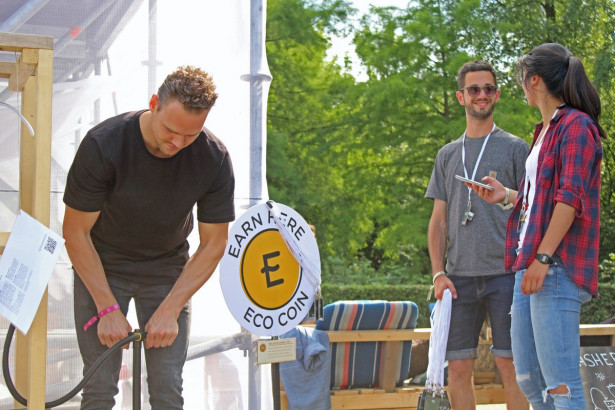
What's been your favorite case so far?
We had some really great results from the L’Oréal implementation. We did a pilot for them last year. It was fascinating because it was the first time we've gone so deep into corporate culture. I think it worked so well because there was already a very competitive atmosphere; they have several divisions, and are always striving to out compete each other. We played into that and grouped the leaderboards per division. That led to really high engagement. You could feel a buzz throughout the whole building, people joking at the coffee machines like ‘oh, how many do you have? I’m buying my coffee today with ECO coins’.
What challenges have you encountered in setting up ECO coin?
Part of it is regulations. The Dutch National Bank is currently passing new regulations on cryptocurrencies, which may limit our future ambitions. I think the challenge is also to get people to see another kind of value system. People really understand euros, because it’s money they've used all their lives. They don’t see the value of other kinds of money until they can actually spend it and get something from it. I would actually argue that we’re using multiple currencies every single day. We just don't think of them as currencies. Think of your loyalty points at a café, or topping up your public transport card. These are technically also tokens or currencies, designated to be used within a specific value system. The ECO coin represents a sustainable value system.
Another challenge we had mainly at the beginning was getting through to organizations to set up partnerships in the first place. Especially as a smaller start-up, it takes a lot of effort and work to connect with the decision makers of these organizations. Something that’s currently still difficult is getting smaller vendors on board for the reward system. Larger companies see it as value that will eventually flow back, and the publicity is often enough for them. We currently tend to pay smaller companies for their products, from the budget that the organization running the ECO coin puts in. We’re now trying to work through other token and business models, such as buy on get one free offers, to eventually move towards a completely self-sufficient system.
How do you see the ECO coin in 10 years?
We’re pretty ambitious. In ten years, we want it to be a genuine alternative system that you would use every day in Amsterdam. It will have become very normal that, when you tap in or tap out somewhere, you choose which currency you want to use – and for sustainable things you’ll be using your ECOs. The goal is also that eventually you’ll be able to exchange your ECO coins into euros, which would add a whole other layer of worth. We have a couple other ideas that we’re currently working out practically. Ideally, every ECO coin will be backed by a tree, just like every euro used to be backed by gold. This could also be a solar panel or wind farm – anything to give it intrinsic value and to double up the CO2 impact. We’ve recently started collaborating with a foundation on the Veluwe that owns 2 million trees, which is a first step in the good direction. We also want our currency to really be a ‘living coin’, meaning every coin will be programmed so that it gradually loses value over time. We do this partly because certain actions will hopefully become more normal and so worth less, but also largely because it drives people to actually go out and spend it. And you’ll be spending it on sustainable products or services, so that speeds up the whole cycle.
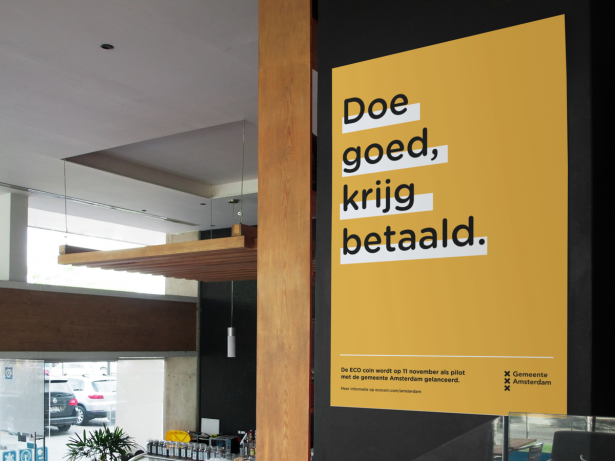
What would you recommend starters wanting to set up a sustainability-related company?
Go and connect with all of the amazing initiatives already out there and figure out where you fit within the bigger ecosystem. Transitioning to the circular economy is about joining multiple things up. You can’t work as an isolated company. It’s what I love about working in this field: traditional startups are constantly competing against each other, but as soon as you step into the sustainability world, everyone’s working towards the same goal and it can only be helpful to work together. It gives you a lot of energy.
-----------------------------------------------------------------------------------------------------
This interview series is a collaborative initiative of Metabolic,** AMS Institute, City of Amsterdam, Amsterdam Economic Board and Amsterdam Smart City. Working together within the Amsterdam Smart City platform, these organizations are committed to accelerate the transition to a circular economy.**
Introduction meeting GO!-NH Accelerator Sustainable Innovation 2020

Introduction meeting GO!-NH Accelerator Sustainable Innovation 2020
With the help of these introduction meetings, you will get to experience the program and learn from participating teams about what the previous programs brought them.
February 10th 2020 - IDEA, Alkmaar - 15:30 - 18:00
Apply through Eventbrite: https://gonh2020-11feb.eventbrite.nl
ABOUT GO!-NH
The GO!-NH Accelerator puts SMEs and start-ups on the fast track to development. New ways of thinking, new skills and new partners are a must. This programme is all about circular economy, targeting sta-ups, innovative SMEs, large organisations and institutions. GO!-NH brings together all the relevant parties to activate, connect and develop this sustainable innovation ecosystem.
In a three-month programme you’ll go from concept to a business offering innovative solutions that’s ready to take the market by storm. Training sessions, tools and professional support from expert practitioners will help you in developing your business in a sheltered environment. The progress you make during these few months would normally take a full year. GO!-NH is a joint venture of the province of North Holland and Innomics.
The Accelerator program enables startups, innovative SMEs and innovation teams from large organizations to convert ideas into new business models in a short time and to accelerate customer and product development in order to shorten the time to market. You develop your business with training, tools and professional support from experts.
Introduction meeting GO!-NH Accelerator Sustainable Innovation 2020

Introduction meeting GO!-NH Accelerator Sustainable Innovation 2020
The GO!-NH Accelerator puts SMEs and start-ups on the fast track to development. New ways of thinking, new skills and new partners are a must. In a three-month programme you’ll go from concept to a business offering innovative solutions that’s ready to take the market by storm. Interested?
With the help of these introduction meetings, you will get to experience the program and learn from participating teams about what the previous programs brought them.
February 10th 2020 - IDEA, Alkmaar - 15:30 - 18:00
Apply through Eventbrite: https://gonh2020-10feb.eventbrite.nl
ABOUT GO!-NH
The GO!-NH Accelerator puts SMEs and start-ups on the fast track to development. New ways of thinking, new skills and new partners are a must. This programme is all about circular economy, targeting sta-ups, innovative SMEs, large organisations and institutions. GO!-NH brings together all the relevant parties to activate, connect and develop this sustainable innovation ecosystem.
In a three-month programme you’ll go from concept to a business offering innovative solutions that’s ready to take the market by storm. Training sessions, tools and professional support from expert practitioners will help you in developing your business in a sheltered environment. The progress you make during these few months would normally take a full year. GO!-NH is a joint venture of the province of North Holland and Innomics.
The Accelerator program enables startups, innovative SMEs and innovation teams from large organizations to convert ideas into new business models in a short time and to accelerate customer and product development in order to shorten the time to market. You develop your business with training, tools and professional support from experts.
Week of the Circular Economy #4: the Zwerfinator

Throughout the week of the Circular Economy, we are shining a spotlight on inspiring sustainable initiatives in the Netherlands. Joining forces with startups, social entrepreneurs, creative professionals, leading companies, and forward thinking governments, to showcase what a circular economy can look like. Meet the pioneers, learn from them and get inspired! Next up is Dirk Groot. Profession: superhero - fighting litter and plastic soup with his Zwerfinator movement.
Throughout the week of the Circular Economy, we are shining a spotlight on inspiring sustainable initiatives in the Netherlands. Joining forces with startups, social entrepreneurs, creative professionals, leading companies, and forward thinking governments, to showcase what a circular economy can look like. Meet the pioneers, learn from them and get inspired! Next up is Dirk Groot. Profession: superhero - fighting litter and plastic soup with his Zwerfinator movement.
So, Dirk, can you tell us about the Zwerfinator?
My personal mission is the battle against litter. I do that by: i) cleaning up, ii) educating people & creating awareness; iii) and most importantly: conducting research. I conduct research by collecting data on litter: what is it, where did I find it and how does this match with the surroundings. Based on the collected data I advise local governments and companies and help them with finding solutions.
I am a data scientist by heart. So I know a lot about data: how to collect, interpret and advise on this data. I started 6 years ago with picking trash and 3.5 years ago with collecting the data.
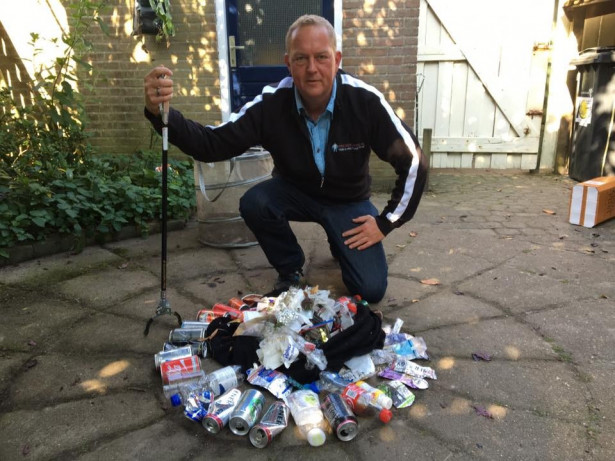
And how do you collect this data?
I use an app: Litterati. This app allows me to upload pictures of every piece of litter I pick up. Besides the picture I add extra data like: what it is, what kind of material, what kind of brand, the exact geo-location, and some extra details. You can see on the map where there is a lot of litter found and see if you can discover certain tracks. It is even possible to find the origin of the litter, for example, is there a company or store that produces a lot of litter? You can see this in the data collected. With this data I can signal to the company that they produce a lot of litter. Together we can try to find solutions like: reducing the amount of packaging or looking at the production of packages, is it possible to use organic materials.
But not only the places that have a lot of litter are valuable: it is also valuable to examine the really clean parts of the city.
How many people are collecting the data?
I see a shift: there is a growing number of people collecting data while picking up trash. I think people are fed up by picking up the same amount of trash, time after time, and they see the value of collecting the data for formulating solutions. It’s a new kind of volunteer work and the plus side is: you can do it anywhere, at any time. If you have an hour to spare, it is sunny, you can just go outside and contribute. In the Netherlands we have about 300 active users of the app, we have the most active members in the world. Worldwide there are about 4,700,000 pieces of litter picked up.
Can you give an example where the collected data made impact?
In June 2018, I started a campaign to create awareness about the commonly found litter, Antaflu wrappers. I encouraged other people to collect and tag these pieces of litter correctly. In total over 30,000 data points are collected now. With this information I teamed up with Merijn Tinga (the Plastic Soup Surfer) and we visited the CEO of Pervasco (the producer of Antaflu candy) in Rotterdam and he decided to change the packaging from plastic to paper, a more organic material.
After this successful campaign, we decided to start a second campaign to pass a policy that bans manufacture and sale of the Knetterbal Firecrackers. (also known as Crackling Balls) We started a movement that managed to pick up and tag over 50,000 littered plastic shells of these firecrackers in two months. After collecting and publishing this information, HEMA and the Albert Heijn decided to ban the sale of these firecrackers. This created a ripple effect inspiring 7 other retailers to remove Knetterbals from their shelves. Great to see that a campaign led to direct results.
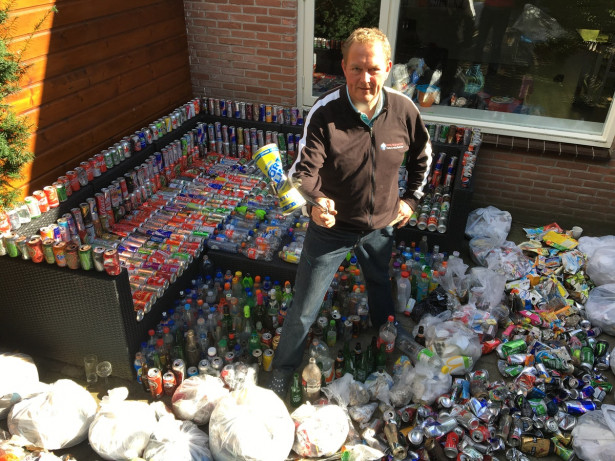
Looking at the future, what will be the next step? What do you need to make your impact even bigger?
I work according to the Forest Gump principle. Do you know what this is? This means that if I have an idea, I start to run with it, just like in the movie. I started alone with an idea to collect data surrounding litter. I talked to a bunch of people, but no one really believed that it could make impact. But I was convinced that it could make a difference. That’s why I just started and run with the idea. Now 3.5 years later the impact and results are tangible and people finally see and appreciate the added value.
Normally you see people having an idea and start looking for investors. For me it works the other way around: I have an idea or hunch and start with the implementation immediately. The rest will follow later.
But the campaigns I did together with Merijn are really successful and I like to do more of those in the future. We’re a good team. He is good in the lobbying and campaigning aspect and I can activate the community of litter pickers to collect the data. Next thing on the agenda is the ‘Plastic Avengers’ conference in Blue City, Rotterdam. Bringing all those individuals battling the plastic or litter problem together. So that they can collectively find concrete and tangible solutions for these challenges. For example in a Hackaton or something else.
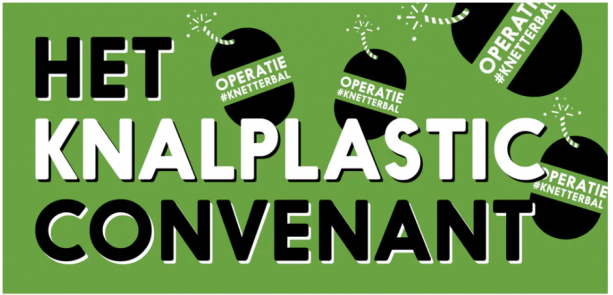
What do you think could be done in your industry to accelerate the transition to a circular economy?
I think there are three important things that I want to mention. First, there needs to be a deposit on all drinking packages. Even everything that has a lid or cap. No exceptions. And making sure it is made of recyclable material. There needs to be some sort of economic incentive for people to take recycling seriously. Second, circular economy can also exist in nature. Not everything has to be recycled for humans. It can also be recycled for nature or animals. Of course with the exception of synthetic materials. Third, we can learn a lot of how people used to live. During and after the war, people lived in scarcity. No food was wasted and what could be reused, was reused. For example, my parents owned a bakery and nothing was spilled: from old or broken pastries we made different, new products. If everyone will live by this mindset, the transition to a circular economy is possible.
-----------------------------------------------------------------------------------------------------------
This interview series is a collaborative initiative of Metabolic, AMS Institute, City of Amsterdam, the Amsterdam Economic Board and Amsterdam Smart City. Working together within the Amsterdam Smart City platform, these organisations are committed to accelerate the transition to a circular economy.
Week of the Circular Economy #1: Upcyclecentre Almere
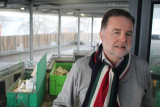
Throughout the week of the Circular Economy, we are shining a spotlight on inspiring sustainable initiatives in the Netherlands. Meet the pioneers, learn from them and get inspired! First up is Henk Martens: Programme Manager of the Upcyclecentre in Almere.
Throughout the week of the Circular Economy, we are shining a spotlight on inspiring sustainable initiatives in the Netherlands. Joining forces with startups, social entrepreneurs, creative professionals, leading companies, and forward thinking governments, to showcase what a circular economy can look like. Meet the pioneers, learn from them and get inspired! First up is Henk Martens: Programme Manager of the Upcyclecentre in Almere.
So, Henk, can you tell us what the Upcyclecentre is all about?
The Upcyclecentre contributes to a circular economy in which raw materials are reused optimally. Residents bring in their waste, and startups on site design and create products from the waste. Old goods gain new economic value, value which in some cases may be higher than the original value. It’s a new concept; people may say it’s the first upcycle centre in Europe. Almere wants to show residents, companies, and other cities that it is possible. But it’s much more than this: the building itself is designed to be circular, with recycled materials. We have 276 solar panels on the roof, and we can collect and reuse rainwater for the toilets. And much more importantly we want to inspire visitors to think and act with a circular mindset. This year we even started offering an educational program for schools.
Every year Almere records 400.000 unique visitors at the waste points.

What kind of startups are on site?
We just had the first batch of startups. Ruig & Geroest makes interior designs, like lamps, from trash, Ruik makes perfume from pine needles or orange peels, & Seefd saves and screenprints pre-loved clothes. The Upcyclecentre gives these circular startups the chance to develop their business cases by offering them a workspace, giving them a small startup capital of €5.000, and helping them with collecting the right used materials. In exchange, the startups have to share the message of circularity and stimulate circular behavioral change by giving workshops to residents, children etc. Now we are looking for the second batch of startups: there is a time constraint on how long the startups can remain on site, to give the opportunity to other circular entrepreneurs, further accelerating the transition to a circular economy. It’s sort of like an incubator program. But the City of Almere still offers the opportunity to join a circular hub district.
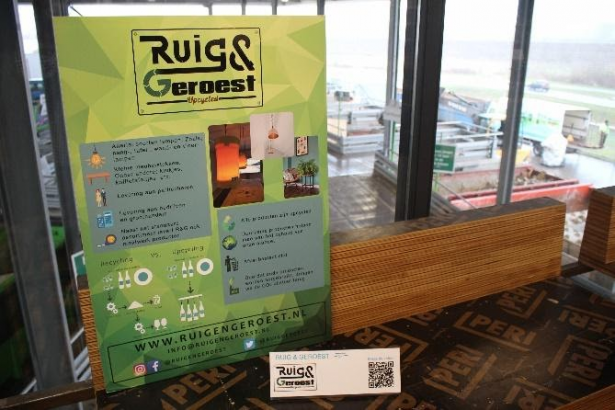
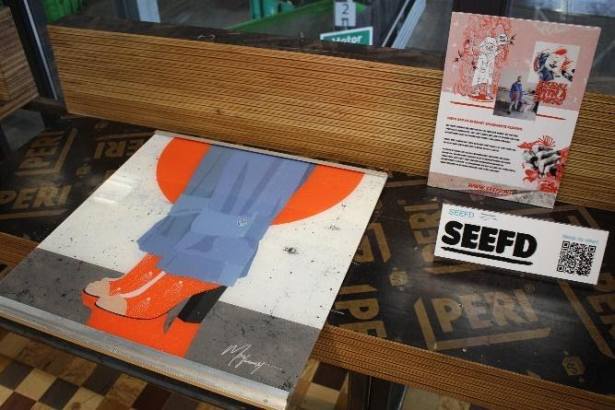
You briefly mentioned that this is the first Upcyclecentre of Europe. Why do you think this hasn’t happened before?
Coincidence or not, Almere is hosting the International Horticultural Expo in 2022: the Floriade. The theme is ‘Growing Green Cities’ and the expo will focus on the green city of the future with growing cities: in 2050 more than 70% of people will live in cities. This created a momentum to do things differently, develop this center and create a showcase for the Expo. It wasn’t easy and it is not something you can do by yourself. The City of Almere collaborated together with the Omgevingsdienst, the Province of Flevoland and the Ministry of Economics & Climate to make this idea into reality.
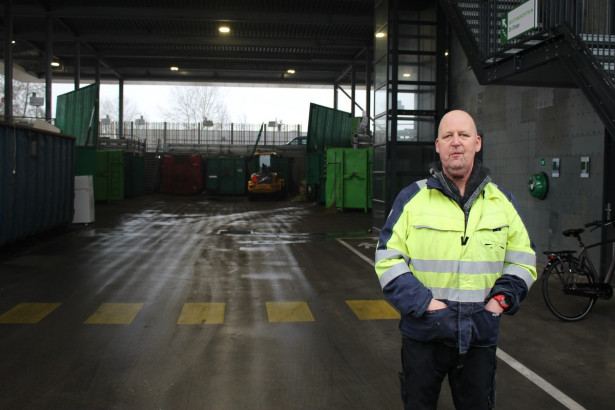
What do you think are the biggest barriers and challenges the Upcyclecentre is facing?
It’s a difficult question. We are really in the start-up phase. 2020 will be the year to prove that the Upcyclecentre has the right to exist and we will focus on measuring the impact we’ve created towards a circular economy. One challenge is the involvement of residents, even more. Or finding the right startups to join the incubator program on site.
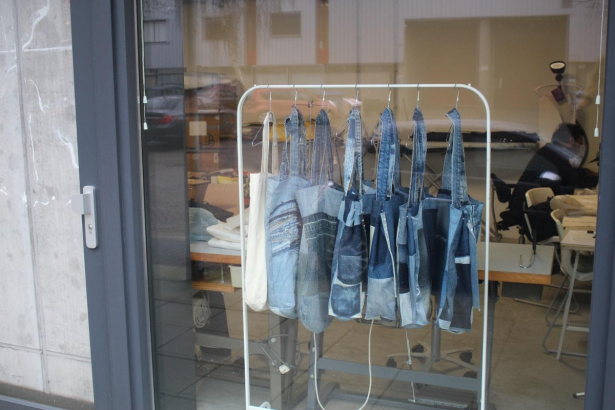
The City of Amsterdam organized a market exploration for a potential Upcyclecentre in Amsterdam North. Do you have any learnings or recommendations for them?
First of all, it is super important to start this initiative with a group of highly motivated people. People who are intrinsically motivated to make this a success. People who believe in the story and want to be an ambassador for the Center. Secondly don’t underestimate the power of good marketing and communication. You want to do this not only for, but also with, the residents of the city. You want to use this center to involve and inspire residents to make this transition to a circular economy happen. This means involving the residents from the start and also reducing potential barriers for users of the center. Make residents your ambassadors as well.
What do you think could be done in your industry to accelerate the transition to a circular economy?
It’s important to show the world that it is possible;a positive outlook on the circular economy. A can-do mentality. That’s what we want to accomplish with the Upcyclecentre. Set an example for the rest of the world and show something concrete and tangible. The city government can take a leading role in this as well. The City of Almere’s initiative is a good example for this.

And if we are looking into the future, where is the Upcyclecentre in 5, 10 or maybe even 20 years?
In a dream scenario all stakeholders have a circular mindset: companies, government, educational organizations and residents. But it’s going to be difficult. The first step is relatively easy: mobilizing the frontrunners. The next step is going to be harder: mobilizing the masses. But with the arrival of the new Account Manager, Hede Razoky, the first step in the right direction is made!
-----------------------------------------------------------------------------------------------------------
This interview series is a collaborative initiative of Metabolic, AMS Institute, City of Amsterdam, the Amsterdam Economic Board and Amsterdam Smart City. Working together within the Amsterdam Smart City platform, these organisations are committed to accelerate the transition to a circular economy.
Week of the Circular Economy | Meet the pioneers, learn from them and get inspired!
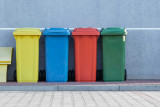
Throughout the week of the Circular Economy, we are shining a spotlight on inspiring sustainable initiatives in the Netherlands. Joining forces with startups, social entrepreneurs, creative professionals, leading companies, and forward thinking governments, to showcase what a circular economy can look like. Meet the pioneers, learn from them and get inspired!
Welcome to the Dutch week of the Circular Economy! Throughout the week, we will be shining a spotlight on inspiring sustainable initiatives in and around the Amsterdam area, by sharing interviews with pioneering projects and companies who are showing tangible solutions to take us from a linear to a circular economy.
Read about startups, social entrepreneurs, creative professionals, leading companies, and forward thinking governments, and learn what a circular economy can look like. We will be publishing 2 articles each day. So, stay tuned!
This interview series is a collaborative initiative of Metabolic, AMS Institute, City of Amsterdam, the Amsterdam Economic Board and Amsterdam Smart City. Working together within the Amsterdam Smart City platform, these organisations are committed to accelerate the transition to a circular economy.
More information about this week: https://deweekvandecirculaireeconomie.nl/
#circulareconomy #WeekvandeCE
Read all the interviews here:
#1 Upcyclecentre Almere
#2 Program Circular Mattrasses
#3 Building bridges from flushed toilet paper
#4 The Zwerfinator
#5 Getting buy-in for products-as-a-service
#6 Loop a.life
#7 Circular Textile Industry
#8 InStock
#9 ECO Coin
Sponsoring zonnepanelen voor KARLOS

Wilt u ook een groener Zuidoost? Sponsor KARLOS en adopteer een zonnepaneel!
Misschien heeft u al van KARLOS gehoord?
Binnenkort rijdt deze elektrische wagen rond in Zuidoost. KARLOS staat voor KAR Levert Overal schone Stroom. Deze elektrische Spijkstaal levert op evenementen in Zuidoost groene stroom, zoals op voorlichtingsbijeenkomsten over schone energie, maar ook op buurtfestivals en andere events. Zo helpt KARLOS de energietransitie in Zuidoost te versnellen. Om KARLOS klimaatneutraal te laten rondrijden en werken, willen we 20 zonnepanelen op het dak van deze wagen plaatsen. Draagt u bij aan een schoner en groener Zuidoost? Steun dan KARLOS met een zonnepaneel.
Investeren in een groene wijk met KARLOS
U kunt €250 investeren in een zonnepaneel voor KARLOS. Daarvoor krijgt u mobiele publiciteit. Uw naam vermelden we namelijk als donateur op de rijdende KARLOS. Maar vooral levert u een bijdrage aan groene stroom op evenementen voor de wijk.
Heeft u interesse om te investeren in een duurzaam Zuidoost?
Neem contact op met Ton Jansen van CoForce 0614-197-373 of mail
ton.jansen@icasus.nl
Op zoek naar een energievriendelijke oplossing voor uw evenement?
Dan kan KARLOS u van dienst zijn. KARLOS is mobiel, levert elektra, werkt als vergaderruimte, opslagplek, podium en faciliteert bij catering. Meer weten? Neem contact op voor de mogelijkheden van KARLOS voor uw organisatie: Dennie Armelita (Moving Arts Project) 0642-874-122, Noud Verhave (Moving Arts Project) 0655-335-465 of mail naar productie@movingartsproject.nl
Van wie is KARLOS?
KARLOS is een samenwerking van Stichting CoForce en kunstenaarscollectief Moving Arts Project en wordt mede mogelijk gemaakt door gemeente Amsterdam en provincie Noord-Holland. Stichting CoForce is een bundeling van bewoners en bedrijven, geïnitieerd door energiecommissarissen van stadsdeel Amsterdam Zuidoost om de energietransitie in dit stadsdeel te versnellen. Moving Arts Project is initiator van KARELs KARAVAAN, het schone wagenpark dat mobiele oplossingen biedt voor klimaatvriendelijke evenementen in de stad. KARLOS is een van de leden van KARELs KARAVAAN.
www.cofroce.nu | info@coforce.nu
www.facebook.com/ikbenkarel | www.movingartsproject.nl | productie@movingartsproject.nl
Hoe kunnen we sociaal-culturele evenementen in de stad duurzamer maken? Dit vroegen wij, het Amsterdamse kunstenaarscollectief Moving Arts Project, ons af. Geïnspireerd door die vraag ontwikkelden we eerst KAREL, de Kar voor Elektriciteit op Locatie, en vervolgens andere schone voertuigen, die met elkaar KARELs KARAVAAN vormen. Deze serie klimaatneutrale voertuigen voorzien evenementen in de stad van schone energie, met allerlei extra faciliteiten. Van een podium tot catering. Van opslagplek tot mobiele vergaderruimte. Van rolmodel als milieuvriendelijk alternatief tot oplaadpunten voor je telefoon.
Wie en wat is KAREL en zijn KARAVAAN?
KAREL staat voor “KAR voor Elektriciteit op Locatie”. Een stalen busje van het oerdegelijke Hollandse merk Spijkstaal, dat al lang voordat het noodzaak werd elektrische wagens bouwde. KAREL vervoert decors, bouwmateriaal, gereedschap en andere productie-onderdelen én voorziet in energie op locatie voor buitenevenementen in Amsterdam.
KAREL is een waar rolmodel. Dankzij zijn zonnepanelen op het dak is hij namelijk CO2-neutraal en verspreidt hij de boodschap van groen en duurzaam dwars door de stad. Behalve KAREL zijn er inmiddels ook:
KARIMA: KAR voor Inductie, Meezingen en Aanhangsels
KARLOS: KAR Levert Overal schone Stroom
en KARLIJN: KAR voor verhaalLIJNen
En de KARAVAAN aan schone voertuigen blijft uitbreiden. Wat alle leden van de KARAVAAN gemeen hebben is dat zij evenementen van schone energie voorzien en andere milieuvriendelijke oplossingen bieden.
Recap: how to move the masses?
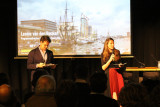
2020 is the year of big events in Amsterdam. The Dutch Grand Prix in Zandvoort, UEFA 2020 and SAIL 2020 will take place in the spring and summer and attract millions of tourists to the region. Add hunderds of festivals and it is clear to see the city and region must be able to deal with large masses of people. How do we ensure that major events are accessible, and which travel methods are available? Which innovations already exist and can help with this? Together with partners of Amsterdam Smart City, big events and event locations, we discussed the accessibility of large events in Pakhuis de Zwijger on the 14th of January.
2020 is the year of big events in Amsterdam. The Dutch Grand Prix in Zandvoort, UEFA 2020 and SAIL 2020 will take place in the spring and summer and attract millions of tourists to the region. Add hunderds of festivals and it is clear to see the city and region must be able to deal with large masses of people. How do we ensure that major events are accessible, and which travel methods are available? Which innovations already exist and can help with this? Together with partners of Amsterdam Smart City, big events and event locations, we discussed the accessibility of large events in Pakhuis de Zwijger on the 14th of January.
The night was opened by program director Amsterdam Smart City, Leonie van den Beuken. She set the goal for the night: as Amsterdam Smart City we would like to accelerate innovations and learn from and with each other. After this, Nathan Wiersma, producer of SAIL, a sailing party with hunderds of tallships and more than 2 million visitors, tells the audience about all the boats that have to enter the Port of Amsterdam, which is quite narrow. And all the boats stay in this small area. Because of all the people, an extra bridge will be built between the city and Java eiland.

In Zandvoort the amount of visitors is a lot smaller: ‘only’ 100.000 people are expected to join the Formula1 races in May. However, Zandvoort is not as accessible as Amsterdam. To get to Zandvoort by car, you have to drive through the City of Haarlem and then take one of the two roads. That is why the City chose the train and the bicycle as the two main means of transport. Before the F1 events, more than 1200 supply trucks have to enter the area. The City places its residents central and doesn’t want to burden them with all the incoming and outgoing. More about the mobility plans of Zandvoort here: https://www.zandvoort.nl/bestandsopslag/introduction/downloads/F1_Mobiliteitsplan/Bijlage_8A_Mobiliteitsplan_Ter_Inzage__anoniem_.pdf

The Amsterdam Metropolitan Area has quite some experience with big events. How does this work? Chris de Veer from the Province of North Holland, Hans Bakker from the GVB (Amsterdam tram and bus agency) and Julie van Heteren from the Amsterdam Transport Authority stress that cooperation is key. The companies and governments have the same goal, which is getting people from A to B smoothly and safely. And after all these events and festivals the authorities know what to do when there are more than 100.000 people in a small area. A few years ago, there was an incident with people walking next to the high ways in the rain, because there weren’t any buses and they had to wait for a long time. Since then, authorities keep weather conditions into account and with incidents like these, all available buses, trams and trains head over to the place where they are needed. To be better prepared for emergencies like these, a complete overview of the city is needed with these kinds of festivals. This overview is also useful if you want to spread people over the different areas.

The panel indicates the role of companies like TomTom and Google Maps in these. They think it is important that all apps and navigation systems provide the same kind of information or cooperate in changing routes or spreading people. Chris thinks it is important to make standards on a European level, so it is clear for companies how governments want to deal with a lot of people in a small area. Therefore it is important to start talks with companies. Chris: ‘Go through all possible scenarios with Google and TomTom. If people have to leave an area quickly, they can redirect people.’
An inspiring presentation was given by Arwind Gajadien from Livecrowd. Livecrowd is a startup that communicates with users via other platforms. Currently they are a landing page for 250 events and festivals. Through e.g. social media platforms they find a way to get peoples’ attention and inform them about routes or alternative routes. The Johan Cruijff ArenA is one of their customers.
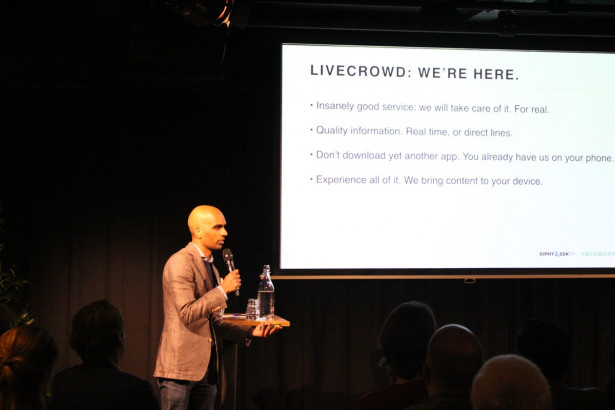
Maurits van Hovell of the Johan Cruijff ArenA, took part in the second panel, together with Upscaling expert Willem van Winden, from the University of Applied Sciences and Erik Tangelder from the RAI Convention Center. The Johan Cruijff ArenA, together with partners, set up a big Operational Mobility Center (OMC). The center keeps an eye on all infrastructure, traffic and people around the area and helps people get to the stadium as smoothly as possible.

The OMC is unique and cooperation succeeds because the challenge is big enough. Parts of the OMC were scaled up to the RAI and Schiphol Airport will start working with an OMC soon. However, scaling up more is quite hard. Willem van Winden thinks that’s striking: ‘There are so many people during many events, how is it possible not to work with an OMC? One of the reasons might be money. If you can’t make money out of it, initiatives are hard to scale up.’ Maurits: ‘Some parties do not see the importance of an OMC and then it is too expensive to set it up.’ Erik: ‘But collaboration on this, can save a lot of money as well. Scaling up makes a lot of processes cheaper.’
From the audience a question raised about mobility as a service. We expect a lot of MaaS solution in the upcoming years. How can the ArenA and OMC deal with that? Maurits tells us the OMC is the ideal place to experiment with MaaS solutions. And since they are not yet there, the OMC continues with its current strategy. Daniel van Motman from the City of Amsterdam is enthusiastic about the OMC: ‘It’s a perfect way to see what is happening with big crowds, you can learn from it and use these lessons for regular developments in the city such as Central Station, shopping streets or developing areas’.
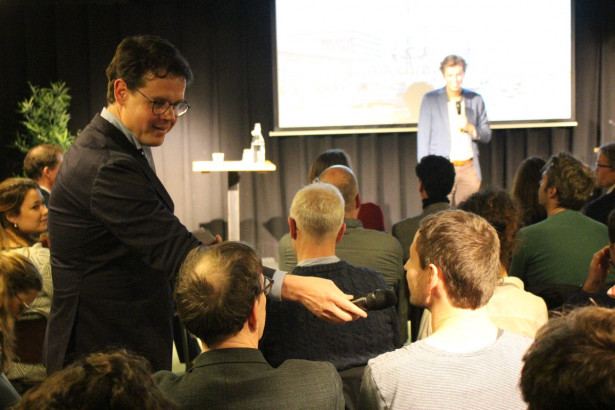
Leonie closes off the evening: ‘We discussed many events and event locations and saw the differences. SAIL can learn every five years and the ArenA can learn every week. However, what we all have in common is the aim for smart solutions. We aren’t looking for more space, more roads or asphalt. We want to do things smarter. And by collaborating, we can achieve that!’
Partners for pilots in our Mobility services
TripService is a joint venture between BeSite and 2Ways.
Through this collaboration we have been able to develop many new services. We would like to use these services to run pilots at events, roadworks or large companies with many buildings.
With these pilots we want to improve our services and enter into multiple partnerships.
Succes op bestelling; Duurzame Logistiek!
De verkeersdrukte in steden neemt toe. Bedrijven en consumenten willen steeds vaker duurzame alternatieven voor producten en diensten.
Duurzame logistiek levert een bijdrage aan de leefbaarheid van Nederland. Vandaag presenteert PostNL een uitgebreide campagne met daarin onze visie op duurzame logistiek.
Beluister #podcasts waarin verschillende experts hun visie geven op duurzame logistiek in de B2B en B2C; bekijk de video's met trends en case studies en lees in de whitepapers hoe je zelf aan de slag kan met #DuurzameLogistiek en #Stadslogistiek.
MobilityXLab in Gothenburg
Dear all Smart Innovators from Amsterdam,
If there are people in the Mobility area that want to take the opportunity to work 4-5 months closely in a vibrant ecosystem of large and small companies in the automotive cluster of the Smart city of Gothenburg ("world leading on many topics"), please look at this:
https://www.mobilityxlab.com/en/get-on-board
If anybody would be visiting MobileWorldCongres ( https://www.mwcbarcelona.com/ ) you can already meet people from Business Region Göteborg and have a one-on-one to pre-qualify.
Feel free to contact me if you would like to have more info (also possible in Dutch).
Best regards,
Leo de Meere
Göteborg
How to move the masses?

Hoe zorgen we ervoor dat grote evenementen in 2020, zoals SAIL, goed te bereiken zijn? De Dutch Grand Prix in Zandvoort, UEFA 2020 en SAIL 2020 in Amsterdam. Verschillende grote, internationale events vinden in 2020 plaats in Nederland. Er worden honderdduizenden mensen verwacht die naar deze evenementen komen. Hiervoor moet een stad of gebied om kunnen gaan met een grote massa mensen. Hoe zorgen we dat grote evenementen bereikbaar zijn, en welke manieren van reizen zijn daarvoor beschikbaar? Welke innovaties kunnen hierbij helpen?
Een van de oplossingen om bereikbaarheid te garanderen is crowd monitoring. De Johan Cruijff ArenA ontwikkelde het Mobility Portal. Hiermee is het mogelijk om gefragmenteerde verkeersinformatie in het ArenAPoort-gebied op eenduidige manier te presenteren. Daarmee willen ze het verkeer beter spreiden. Wat is het precies? De Mobility Portal is in feite een online platform waarop de bezoekers alles over het vervoer kunnen vinden van en naar het gebied toe. Je voert je postcode in, dan weten zij waar je vandaan komt. Op basis hiervan meten ze de verkeersintensiteit en kunnen ze mensen via nieuwe routes naar het gebied laten komen. Als resultaat hopen ze dat dit opstoppingen in het verkeer tegengaat.
Maurits van Hövell, consultant Mobility & Environment bij de Johan Cruijff ArenA, staat op het podium tijdens ons programma in Pakhuis de Zwijger. Maurits zal in gesprek gaan over de voorbereidingen van EURO 2020 qua bereikbaarheid en hoe de mobility portal ook bij andere grote evenementen een rol kan spelen.
Wil je meer weten over het Mobility Portal? Bekijk dan het project op ons platform: <https://amsterdamsmartcity.com/projects/mobility-portal-co011ghp>
Zien we je dinsdagavond 14 januari in Pakhuis de Zwijger? Meld je dan nu gratis aan: <https://dezwijger.nl/programma/how-to-move-the-masses>
Get Axis In-Car Experience Report!

Axis Innovation team is very excited to share our latest industry report about the future of the In-Car Experience. Based on our firsthand experience working with leading automotive companies and startups since 2013, the report analyzes the challenges and massive opportunities of the in-car experience, offers our predictions for the future, and shares our latest thinking on how all sides of the mobility ecosystem can position themselves for success with the in-car experience.
Thanks to our Dealflow Manager Jason Weiss for working on this for months! Click here to get the report for free >> https://reports.axisinnovation.com/in-car
If you have any thoughts or questions, don't hesitate to reach us by email info@axisinnovation.com
Apply now to pitch your startup to 1,000+ attendees at REVOLUTION 2020
REVOLUTION is thé event about the future of mobility, taking place on the 31th of March 2020 in Amsterdam. Every year REVOLUTION brings together the mobility industry with one goal in mind: accelerating the transition towards sustainable mobility.
For the first time ever at REVOLUTION, we're giving startups the opportunity to pitch their idea to 1,000+ attendees. Powered by StartupAmsterdam and EVBox, 10 startups will showcase their innovations! Are you one of them?
Fellow members of the Amsterdam Smart City community, check out the criteria and apply here 👉 https://bit.ly/34fBWOW
How to move the masses
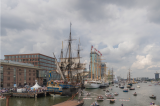
Hoe zorgen we ervoor dat grote evenementen in 2020, zoals SAIL, goed te bereiken zijn?
De Dutch Grand Prix in Zandvoort, UEFA 2020 en SAIL 2020 in Amsterdam. Verschillende grote, internationale events vinden in 2020 plaats in Nederland. Er worden honderdduizenden mensen verwacht die naar deze evenementen komen. Hiervoor moet een stad of gebied om kunnen gaan met een grote massa mensen. Hoe zorgen we dat grote evenementen bereikbaar zijn, en welke manieren van reizen zijn daarvoor beschikbaar? Welke innovaties kunnen hierbij helpen? Samen met partners van Amsterdam Smart City gaan we in gesprek over de bereikbaarheid van grote evenementen zoals SAIL2020.
Stay up to date
Get notified about new updates, opportunities or events that match your interests.

